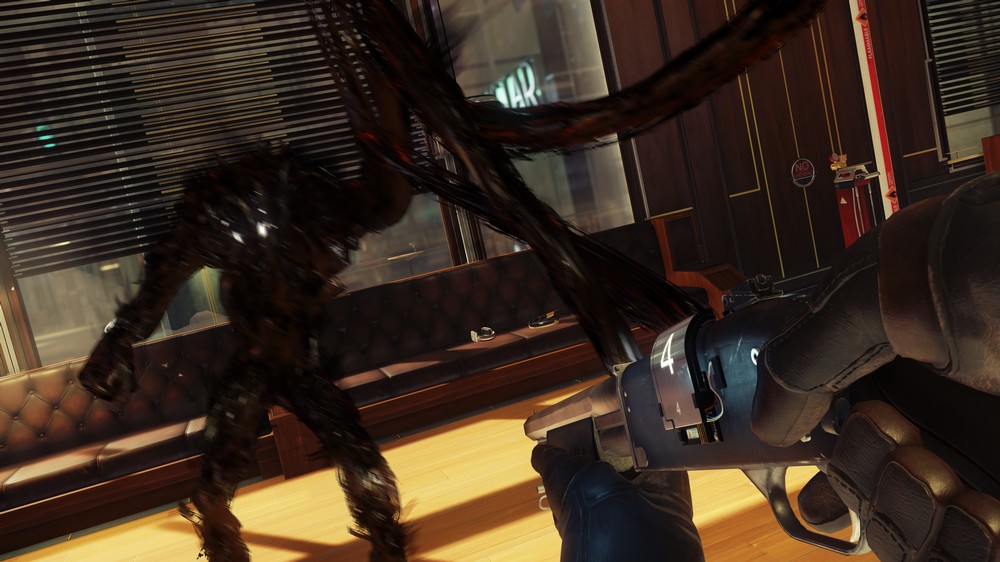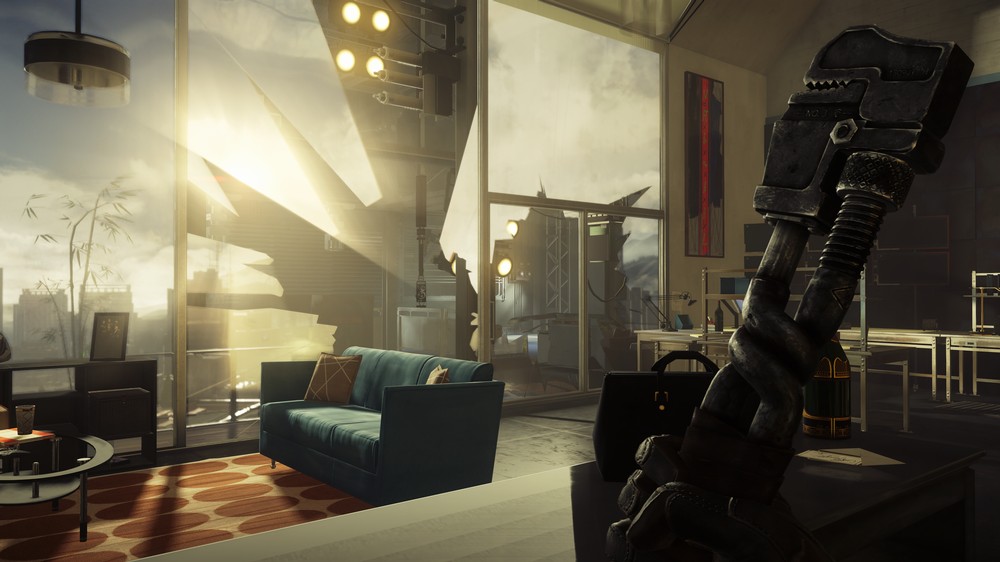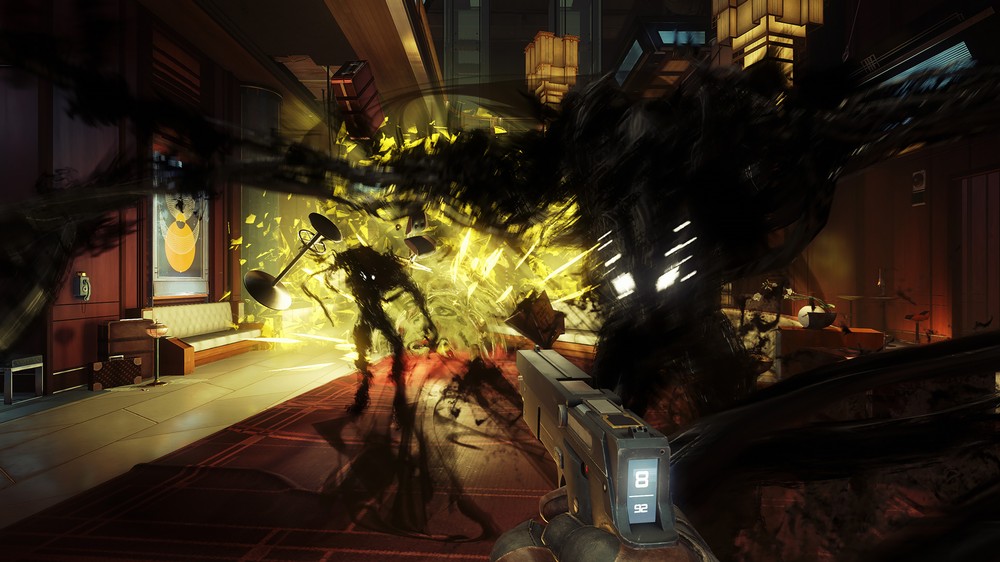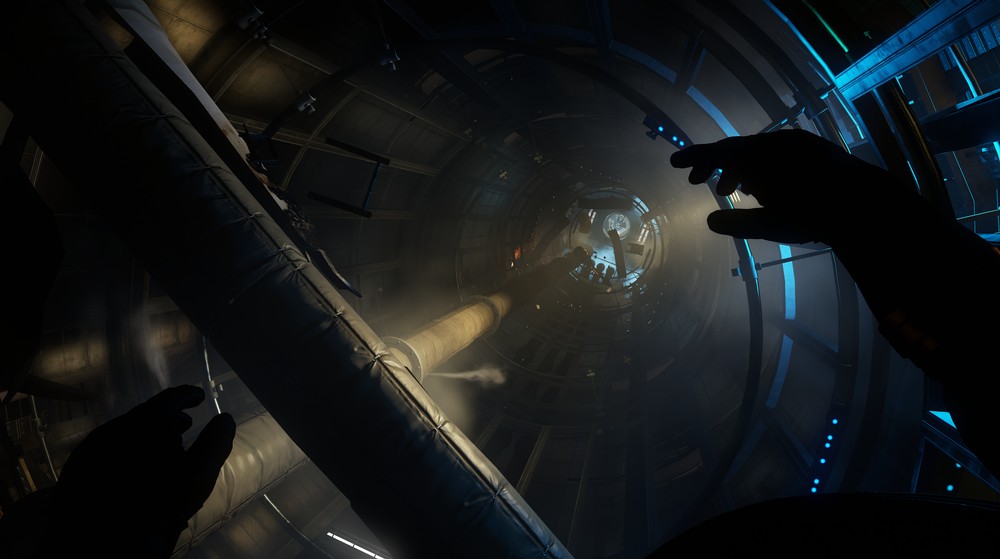By now it is no secret that Prey has absolutely nothing to do with the original game of the same name from 2006 nor anything to do with the bounty hunter themed trailer from a few years ago. Arkane Studios has instead created a space station survival game where in fact YOU are the prey, and your hunters are a race of shapeshifting aliens. As one of very few remaining survivors it is up to you to not only survive but unlock the secrets of the Talos I station and the alien invasion and maybe save a few other survivors along the way.
If Prey were a movie, it would be a period piece, locked somewhere in 60’s design themes and nostalgic architecture not unlike the BioShock games. In this alternate universe JFK was never assassinated in Dallas and our race to the stars was greatly accelerated leading us to the space station we find ourselves exploring. All of this rich backstory can be found within the game as long as you are patient enough to listen to the kiosks and read all the collectibles.
The game opens at a leisurely pace, introducing us to Morgan Yu. You get to pick the gender as well as tailor their ongoing character development in what will soon become a fairly elaborate skill tree. The game design is all too familiar where you explore the environments and click on nearly everything, either to get a text description or pick something up. While this exhaustive exploration process borders on grinding in most other games, Prey mixes things up in a few ways.
First, everything, no matter how useless, can be recycled into useful material that can then be used to create even more useful inventory items from med kits to ammo and more. Scattered about the station are recyclers where you toss your junk items into a bin and press a button to turn them into material cubes that can be used to fill recipe requirements at construction terminals, usually located nearby. You’ll also discover new blueprints that unlock advanced devices like an EVA suit that allows you to explore outside the station in some cool zero-g moments.
Just about the time you get comfortable clicking on everything with an icon Prey throws its main plot device at you – the shapeshifting aliens that can (and will) take the form of those everyday items you’ve been casually clicking. The first time a chair or a desk lamp or a coffee cup turns into an inky blob version of an alien face hugger and attacks will make you jump, and it’s no less scary 8-10 hours into the game; although by then you’ll have far worse aliens to deal with.
The humanoid versions of the aliens are incredibly dangerous, able to kill you with two or three hits forcing you to be extra cautious and even a bit tactical, even in the later levels where you have weapons better than your initial wrench. You will definitely want to be constantly evolving your character by assigning skill points and upgrading your weapons to meet the deadly demands of the final half of Prey.
The skill tree allows you to tailor the game to the way you like to play, and almost every puzzle in Prey has multiple solutions that fit with key skill paths. If you enjoy hacking (which involves a terrible maze puzzle game every time you do) then you can boost that ability, but if you would rather force open a door or throw a chair through a window then boosting your strength/lifting ability might be the way to go. Later puzzles might involve a Nerf-style crossbow or even some shapeshifting abilities of your own. Likewise, you’ll want to spend those weapon upgrade kits wisely, as a fully powered shotgun can bring down most aliens in one or two shots.
You can’t talk about Prey without a quick mention of the Goo gun, which not only encases enemies in “goo”, allowing you to get several free attacks in on them, but can also be used to create these large popcorn-like foam blobs that stick to each other and can be used to build bridges and stairs, often leading to secret areas and hidden collectibles. There is a metric ton of stuff to collect and thanks to the recycler all of it is eventually useful, but inventory space is limited in that typical grid style fashion that forces you to constantly micromanage your stuff; at least until you can increase your capacity.
Later in the game you also get this cool visor that allows you to bring up a “detective overlay” where you can scan items and aliens for useful information that all feeds into your research bank which all plays into yet another level of character development. Exhaustive research of the aliens will certainly help you defeat them more efficiently in the final chapters.
Prey has a solid 20-hour story that will take you to all parts of the Talos I station, inside and out. Airlocks must first be unlocked from the inside, but once they are, provide a quick and relatively safe way to travel to areas of the station avoiding needless alien encounters. When you aren’t checking off the tasks of the primary objective list there are dozens of secondary missions as well as survivors in need of rescuing. All of these can easily double your play time. Sadly, Prey does bog down in the third act when you are forced to endure a lot of repetitious backtracking through previous areas. Sure, there are fresh encounters, but it seemed like needless padding in a game that was already overstaying its welcome.
Also increasing your playtime is the sheer number of times you will die. Prey is hard, with enemies that can send you back to checkpoints with one or two hits or drain your ammo supplies when you defeat them. Resources are finite and you can easily get yourself into a situation where the game is going to be impossibly hard to continue or you will just need to reload an earlier save and try to do better. There were many times when I needed to go into an area and needed more shotgun ammo, but first had to backtrack through numerous areas picking up random recyclables to create more ammo. Sadly, there isn’t a lot of stealth in Prey, and enemies will detect you far too easily and descend upon you in ruthless fashion. Its times like these where repair and hacking abilities are useful to get security turrets working for you.
The presentation in Prey is outstanding; again, mimicking the look and feel of the BioShock franchise with a unique blend of architecture and technology that you’d imagine in your head while reading a Jules Verne novel. The level of micro-detail is unprecedented, mostly due to the sheer number of interactive items found in the game. Character designs are good and a bit quirky in a surreal way, but it’s the alien creatures (in all forms) that steal the show with their startling morph transitions and smooth animations as they skitter toward your face. All of the visuals are supported with some fantastic voice acting, mostly in videos and recorded logs, as well as a soundtrack that is so engaging and so good you will certainly want to consider getting a copy to listen to outside the game.
Prey is available on both console and PC and there seems to be reported random issues with all versions; most of which are being addressed through patches to the game. Thankfully, I had no issues during my playtime, which on an i7/GTX980ti for the first half in 1080p and a GTX1080ti for the second half in 4K provided unwavering 60fps at max settings on both cards. While not as photorealistic as some of its competition, Prey oozes with a unique style all its own.
Prey has a sense of danger and urgency about it that I never felt when playing games like BioShock or Dishonored. I was always moving a bit slower and looking around corners or listening for audio cues in the immersive 7.1 sound mix, because any surprise alien attack can and would often kill me in just a couple hits. While it lacks the fear factor of a game like Dead Space, there is still plenty of tension and suspense waiting for you in Prey along with a genuinely gripping story and some excellent character development that will have no two games playing out the same. Just remember; the coffee in Prey might not kill you but watch out for the cup.






















